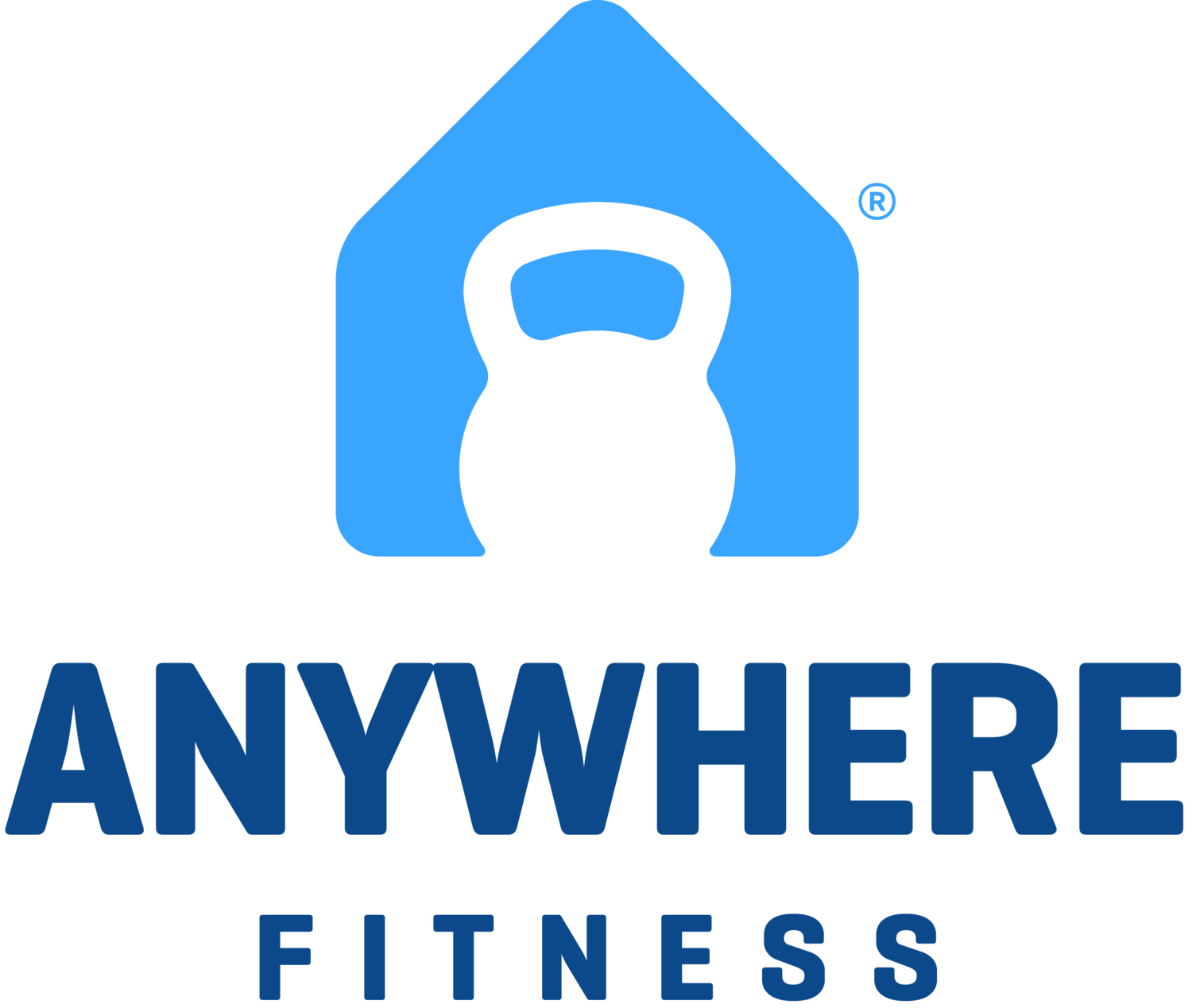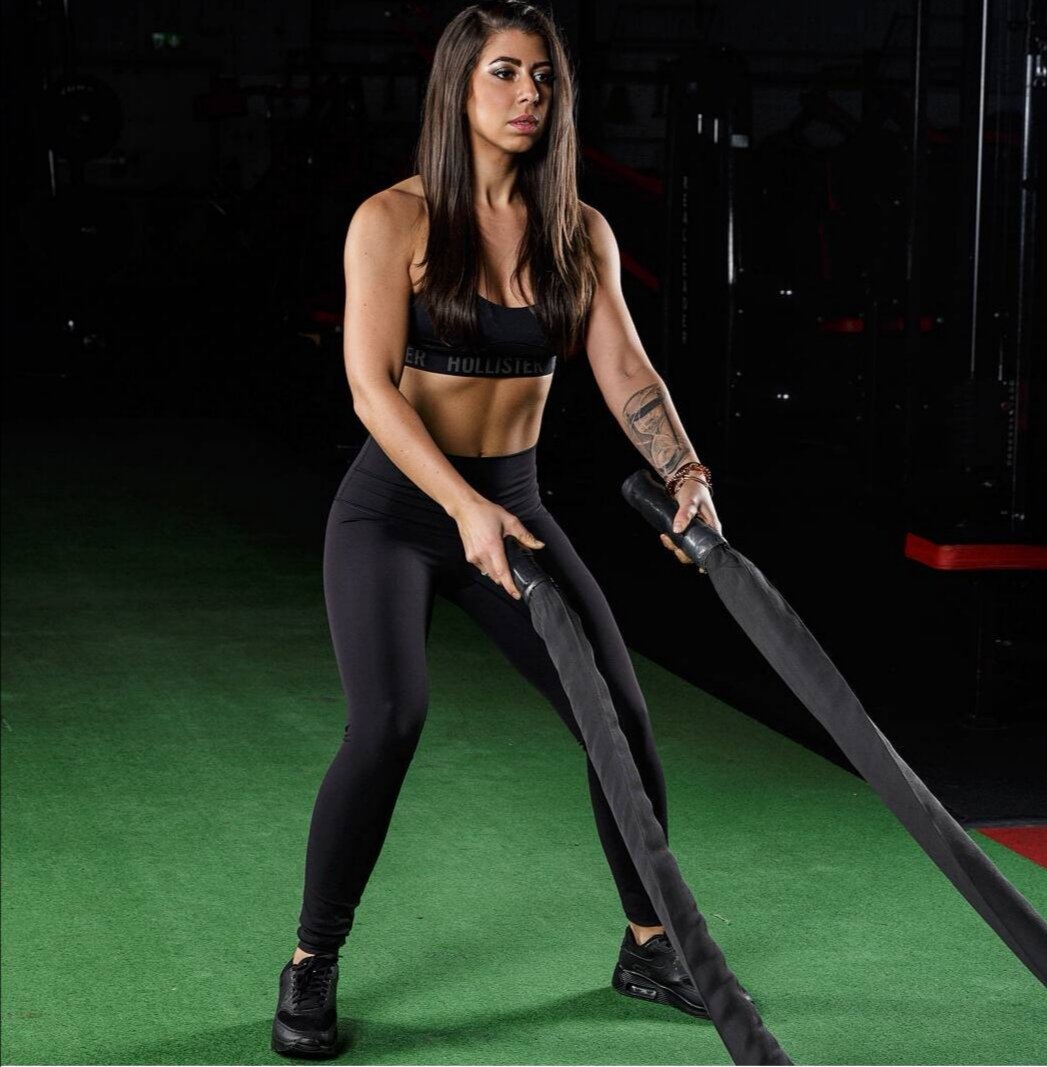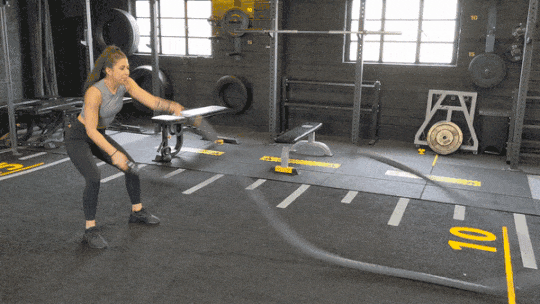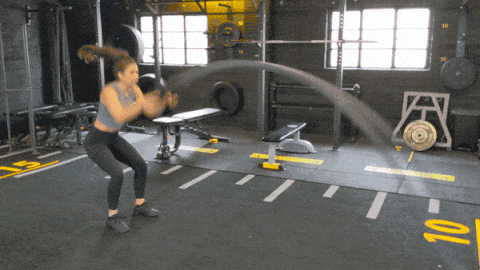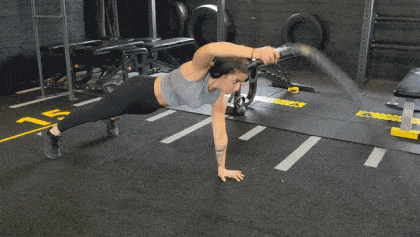FULL BODY BATTLE ROPE WORKOUT
WHY ARE BATTLE ROPES CONVENIENT FOR YOUR FITNESS PROGRAM?
It’s no surprise that battle ropes are becoming extremely popular in the fitness world. They’re one of the most versatile pieces of fitness equipment to purchase for your home gym. Battle ropes can virtually improve every aspect of your fitness. They’re inexpensive and easy to store without taking up too much space. They’re portable and can be used almost anywhere! To keep your workout dynamic, there’s countless variations of different exercises to choose from so you won’t get bored.
Building a gym with dumbbells and barbells can be a hefty investment. You could end up spending a fortune collecting different weights if on a tight budget. Resistance bands are cheap and effective but you’ll need multiple sizes, lengths, and degree of thickness in the bands to progress with a strength programme.
As one solid piece of equipment, battle ropes will help you increase your range of motion, strength and power, as well as aerobic and anaerobic fitness. Knowing how to utilise them to their potential can make you a well rounded athlete.
HOW CAN BATTLE ROPES IMPROVE DIFFERENT ASPECTS OF YOUR FITNESS?
CARDIOVASCULAR FITNESS
Battle Ropes are a great tool for improving your cardiovascular fitness. They can be used for HIIT (High-Intensity Interval Training) style workouts or as an alternative for low-impact cardio exercises such as running or cycling. When using battle ropes, you can transition from light to intense activity instantly. It’s quicker to make this change than adjusting the settings on a treadmill, stationary bike, or elliptical machine. The equipment is very useful for interval training for this reason.
FAT LOSS
Battle ropes are a great fat-loss tool for multiple reasons. They help elevate your heart rate quickly and burn a significant amount of calories in a short period of time. Unlike steady state cardio (using a treadmill or elliptical), you’re using your entire body to perform each functional workout with battle ropes. This stimulates the response of muscle growth and increases your metabolic rate for hours after exercise. Two factors that contribute to burning fat effectively. Having active muscle tissue and boosting your metabolism helps to burn more calories at rest. When we consume energy (food), our muscle tissues need these nutrients to build and recover before storing as fat.
As mentioned, battle ropes are great for quickly shifting the intensity of your workout. This keeps both the aerobic and anaerobic system active during your session. Aerobic fitness burns energy from fats. Anaerobic fitness burns carbs and sugar as a fuel source during training. Making battle ropes the ultimate fat loss tool when combining many dynamic workouts.
STRENGTH
Battle ropes provide a great functional workout. They’ll target muscles that you might not have known existed. To be more specific, they’ll target muscles that you’ve been missing when designing a strength program with machines, dumbbells and other weight equipment. When looking to gain strength from your battle rope routines, keep mixing up exercises that challenge you and change the variations. For example: increase the time or repetitions, decrease rest periods, and add more impact to the drills (such as jumping). Increasing the variations and the tempo of your workouts is essential for becoming stronger.
As an excellent source of information, check out this article on “How Battle Ropes Can Improve Powerlifting and Weightlifting”.
MOBILITY AND STABILITY
Performing any dynamic exercise with battle ropes will improve your mobility and stability. This is extremely important for improving your functional fitness and enhancing sports specific activity. Battle ropes increase your range of motion (mobility) by strengthening the small muscles around your joints that often get over looked or neglected. The primary areas targeted in these exercises are the hips and shoulders, which happen to be the most important joints in our body for performing the majority of functional movements. Battle ropes also increase core strength and stability. When performing most exercises, the core muscles are strongly activated when keeping your feet planted on the floor. This can be said especially for the drills that promote unilateral movement.
BALANCE AND CO-ORDINATION
By moving the ropes independently and adding various movement patterns to your routine, you’ll promote better balance and coordination and target many stabiliser muscles. This will help when performing many exercises that require more stabilisation such as walking lunges, step ups, one legged deadlifts etc. It will also enhance your motor senses for performing every day activities.
IMPROVES MUSCULAR IMBALANCES
You might notice that one side of your body is stronger than the other, or particular muscle groups are weak and less functional. Adding unilateral exercises to your battle rope routine can help solve these muscular imbalances. Unilateral exercises constantly work the stabiliser muscles on one side of the body. These muscles are worked constantly when using battle ropes. To balance them out, perform more repetitions and increase the time of your workout.
THE 7 BEST FULL BODY BATTLE ROPE EXERCISES
1) ALTERNATING WAVES
While most battle rope exercises provide a full body workout, “alternating waves” apply more emphasis on the arms, shoulders and upper back, while recruiting your core and legs for stability.
In my opinion, this is the best battle rope exercise to learn. Once mastered, you can make it more dynamic and challenging by adding multiple positions to the workout. This helps to target different muscle groups as prime movers during the exercise. For example, if performing the alternating waves in kneeling position, it puts more emphasis on the upper body (shoulders, arms, core). If performing the exercise in a more squatted position, it builds greater strength in your legs. If transitioning between different positions, such as standing, squatting, or even reverse lunges, you can increase your heart rate, burn more calories, and distribute more emphasis on different body parts at the same time.
HOW TO DO
Stand with your feet slightly wider than shoulder width apart. Advance into a semi-squatted position and hold the end of the battle ropes with your palms facing each other.
Keeping your torso upright and chest out, begin to whip the rope up and down using your wrists. Alternate the movement between your left and right arms to make vertical waves.
To prevent your hips from swinging back and forth, keep them square and engage your core while picking up momentum (This will help you from lifting your feet off the ground). Keep your shoulders back and don’t let them round forward.
TIPS
You can create smaller waves by flicking the wrists quicker and moving the arms up and down faster. This gives your shoulders a harder workout and increases your heart rate more for burning fat.
2) ALTERNATING WIDE CIRCLES
This exercise is very beneficial for building strength in your rotator cuff. It also works the muscles in your arms, shoulders and upper back. While handling its intense unilateral movement, many stabiliser muscles are worked in your core and legs. Alternating wide circles are the ultimate battle rope exercise for promoting balance and coordination while improving core/hip stability. This workout also challenges your hand grip.
With the arms moving freely through a very wide circular movement, this drill is great for improving range of motion in the shoulder joint and fixing tight or imbalanced muscles.
HOW TO DO
Start with your feet slightly wider than shoulder width apart. Come to a slightly squatted position (45 degrees).
Hold the ends of the battle ropes with your palms facing each other.
Move your arm upwards and out to the side in an arc (as if you are drawing half a heart). When your hand comes back to centre, perform the same movement with the hand on the opposite side.
Continue to alternate circles while picking up momentum. Keep your legs stable on the floor while trying to make the movement as large as possible.
TIPS
Be sure to engage your core and use your legs for stability. It’s harder to start back up again once you stop, so use the momentum you create to your advantage.
3) POWER SLAM & JUMPING SLAM
Power slams and jumping slams are a great anaerobic workout with the battle ropes. They generate a lot of explosive power. This workout is great for building muscle, strength, and improving athletic performance for sport specific activities such as plyometrics, sprinting and various track and field events that require a high level of anaerobic fitness. With slams, you can burn a lot of calories from all fuel systems in your body in a short period of time. The primary muscles used are the abs, shoulders, upper back and lower traps. Secondary muscles used are your quads, glutes, hamstrings and calves. Slams are an elite drill for whipping yourself into shape.
HOW TO DO
VERTICAL DOUBLE WAVE
Start with your feet roughly hip width apart.
Squat to appoximately 45 degrees and hold the ropes with your palms facing each other.
Keeping yours arms extended, lift the ropes and keep them just below shoulder height. Slam them down and then immediately whip them back up.
Continue with this pattern as you make vertical waves with both ropes together. Keep a soft bend in the elbows and keep your hips square at all times.
POWER SLAM & JUMPING POWER SLAM
Start with your feet roughly hip width apart.
Keeping the same technique above, this time you’ll lift both arms overhead before slamming the ropes to the ground. Make sure you’re using your legs to generate power when lifting the ropes overhead (not just your arms).
Extend your hips back a bit further when slamming to the floor to use more power from the lower body.
To make it even more challenging, you can jump as you bring the ropes overhead. This adds an element of explosive power to the movement.
4) ALTERNATING WAVE LUNGES
“Alternating wave lunges” are a very dynamic and challenging exercise. Apart from working the same muscles in your upper body as standard alternating waves, you’re also maximising the potential strength of your core, legs, and glutes when stepping back and powering yourself back up to the starting position. This exercise requires a lot of balance and co-ordination, lunging back and producing vertical waves with the upper body simultaneously. Be patient, this one takes a lot of practice!
HOW TO DO
Start with your feet together with a slight bend in your knees.
Hold the battle ropes with a neutral grip and both palms facing each other.
Applying the same technique, start performing alternative waves until getting into a solid rhythm
Once feeling stable in your core, step back with your right foot and bend the right knee so it hovers about a centimetre off the ground. Drive through the heel of the left foot to bring you back to the starting position. While performing this movement, continue to make vertical waves with the upper body.
Repeat on the opposite side when completing your repetitions.
5) JUMPING JACKS
Doing jumping jacks with battle ropes will really get your heart rate pumping and build strength in the smaller muscles around your scapula. You will also build strength in your shoulders (medial, lateral deltoid) and upper back (traps). It’s a highly aerobic and anaerobic training drill and great for burning fat and glucose as an energy source.
HOW TO DO
Start with your feet together and hands by your sides. Hold the battle ropes with a side grip with your palms facing each other.
As you jump a little wider than shoulder width apart, bring your arms up to shoulder height. Keep your arms straight with your elbows slightly bent. Use the momentum of the continuous jumps to bring the ropes up high!
Slam the ropes back down to your sides as you jump inwards, bring the feet together once again.
Repeat the movement for several repetitions.
6) RUSSIAN TWISTS
Russian Twists are an elite core workout for building strength in your obliques and lower abs. When performing the drill with anchored battle ropes, it also works as an upper body workout for your shoulders, arms and chest. They’re also a great way to build core/spinal stability and balance.
HOW TO DO
Start in a seated position on the floor or mat.
Face where the ropes have been anchored in an upright position. Your back should be leaning backwards slightly while sitting straight. This will engage your core. Keep your shoulders back and down away from the ears.
Keep your heels grounded with your knees slightly bent. Hold the ropes close together at the midline of your body.
Keeping your arms extended and elbows slightly bent, slam the ropes down to each side of your body while looking ahead. Rotate your torso slightly to control the movement without changing position.
TIP
Make sure to keep your spine long during the exercise. If you notice pain in your lower back, it means your back is taking the load instead of your core. You may need to practice without the ropes and with a lighter object until getting stronger.
7) PLANK WAVES
The plank by itself is a great exercise for strengthening the deep muscles of the core. By making it a one arm plank and adding ropes to the equation, it becomes an even bigger challenge for your abdominal and stabiliser muscles. You’ll notice differences on each side of your body. It’s common for one side to be stronger and notice where the other side is weak or tight. Once you become aware of your weaknesses, they become easier to target. “Plank waves” are great for exposing what needs work! The up and down movement of the rope also strongly activates your obliques and all the muscles in our upper body. The unilateral movement also requires the legs to stabilise the movement.
HOW TO DO
Set yourself up in a “high plank position” with your hands on the floor.
Make sure your hands are directly under your shoulders, legs and back are aligned straight, and core engaged.
Pick the rope up off the floor with one hand. Hold it with a side grip. Before starting, pull your belly button into your spine and slightly protract your shoulder blades back. Keep your hips and shoulders square.
Keeping your arm straight and elbow slightly bended, start to whip the rope up and down, creating a lateral wave (kind of like a snake). Try not to let your hips wiggle by squeezing your glutes and engaging your core.
Keep this movement consistent for the duration of the exercise.
CONCLUSION
To design a full body workout program, you can use these battle rope exercises together, or add them to a workout that has full body exercises with other equipment (see full body resistance band workout). Battle ropes also serve as a great finisher for your session when looking to increase your fitness levels. Each drill will increase your heart rate, improve cardiovascular fitness, strength and endurance. Choose a work to rest ratio that challenges you best. Choose exercises where the work period is shorter - this will increase your ability to work and push harder! (anaerobic, power, strength) Choose exercises that are light and continuous for longer durations (aerobic, fat burn)
To increase your endurance levels, try to decrease the rest times for some exercises between sets.
For example you could do Alternating waves for 30seconds, then rest 30 seconds. Power slams for 30 seconds then rest for 30 seconds. Russian twist for 30s rest for 30 seconds. Repeat this 3 times.
More Battle Rope Workouts Online
Stack: 10 Battle Rope Exercises To Build Endurance For Athletes
Coachmag: Battle Rope Exercises And Workouts To Get You Ripped
